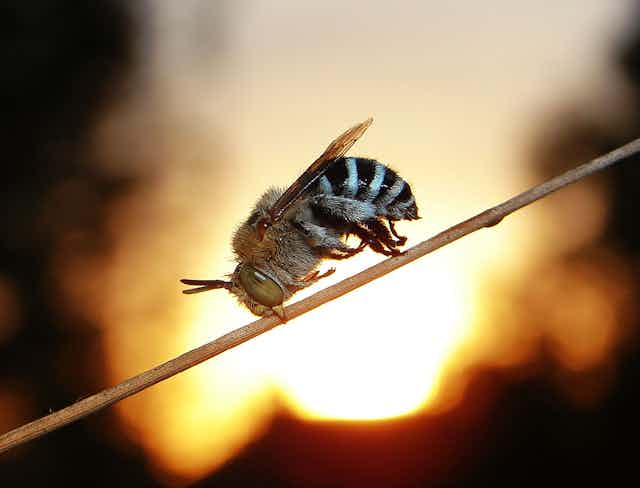Honeybees are in trouble - a stressful lifestyle and an unhealthy diet are being compounded by mite attacks - but we needn’t panic about pollination. Australia has many native bee (and other pollinator) species that could be taking care of business, if we only took better care of them.
What do we mean when we talk about “bees”?
For many, “bee” means the honeybee – any species in the genus Apis, the most well-known of which is Apis mellifera, the European honeybee. It is a generalist pollinator, which means it shows little preference when it chooses flowers to forage on. It could visit (and potentially pollinate) almost any open flower in its foraging range. It is also adaptable to a wide range of environments and is capable of being “domesticated”.
Today, honeybees supply local food and pollination services to home gardeners around the world. Undomesticated honeybees are an important source of free pollination services to many farmers, while managed hives are one of the most common management inputs in commercial crop systems. Their close association with agriculture has prompted many to see honeybees as a symbol for “global food security”.
But honeybees are not the only pollinator insects. Around the world, there are more than 20,000 known bee species, over 100,000 wasps and 240,000 flies – all likely candidates for pollinating activities. There are also plenty of beetles, ants, moths and butterflies available for the role.
Unfortunately, agricultural intensification, habitat fragmentation and other environmental changes have had severe impacts on native pollinator communities globally.
Many intensive crop systems now rely heavily on “renting” honeybee hives for the crop flowering season to maintain productivity. This demand has caused parallel intensification of the honeybee (or pollination) industry. And this intensification means that a commercial honeybee now leads an itinerant existence, despite its inherently “sedentary” nature.
Today, commercial honeybees are loaded on and off trucks and shipped around the country to follow crop blooms. They are under constant physical stress, continuously adapting and re-adapting to new climates, microclimates, landscapes, and floral resources. In between jobs, they are force-fed sugar syrup or other unnatural diets, a practice that affects the health of the hive.
They are also exposed more frequently to pesticides, some of which have recently been proven to be lethal to hive survival. This lifestyle is not salubrious for the bees – it can only benefit the pests and diseases that thrive in intensively-managed, stressed communities.
Yet what choice is there, when in many places, there is little knowledge of other crop pollination options?
As has been discussed on The Conversation before, losses in our national honeybee population, managed or unmanaged, are inevitable. It is only a matter of time before Varroa destructor crosses our shores and takes its toll on our already stressed honeybee hives.
And these losses will not just affect food production. The honeybee is also essential to the future of our honey, beeswax and health industries (honey, beeswax and propolis are all valuable antibacterial substances), and it is a treasured visitor in productive home gardens, market gardens and school vegetable patches around the country.
However, it is not all doom and gloom. Australia has its own diverse native bee fauna, and a myriad of other potential pollinator insects. We may not be able to stop Varroa destructor, but we can take some of the pressure off our indispensable honey-makers by turning our attention to our understudied native pollinators.
Research from other countries has established the value of native or “wild” pollinators in a variety of agroecosystems. Sadly, there is very little published research into the potential for Australian crops to benefit from native pollinators. This is despite current commercial use of native stingless bees for macadamia pollination along the east coast, and successful pollination of other commercial crops from Rockhampton melons to Griffith onions.
Impacts on our honeybee industry may be inevitable, but we still have time to reduce the extent of their effects. After all, global food security starts at home. By building reliable, self-sustaining agroecosystems that incorporate the natural systems and processes around them, we can guarantee both a healthy environment and a robust food production future.
We can encourage agricultural managers to invest in permanent on-site bee populations, thereby reducing the stress on the valuable honeybee. We can also invest in more research to build our knowledge of Australian pollinators.
Experts have already highlighted the urgent need for taxonomic research into Australian bees and other pollinator insects. We also need to invest in ecological research on our pollinators including their pollination capabilities, and their interaction with local habitats, both natural and agricultural.
Most importantly, we need to come to grips with the ecological management of our agricultural landscapes to encourage native pollinators, animals that are essential to the function of both natural and managed ecosystems.
Thank you to Steve Maginnity for information on native bee crop pollination services.

